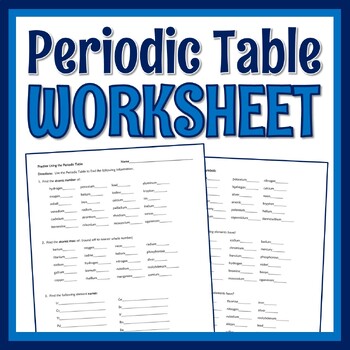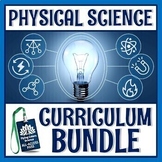Elements of the Periodic Table Worksheet
Flying Colors Science
4.8k Followers
Grade Levels
7th - 10th
Subjects
Resource Type
Standards
NGSSHS-PS1-1
NGSSMS-PS1-1
Formats Included
- PDF
- Easel Activity
Pages
3 pages
Flying Colors Science
4.8k Followers
Easel Activity Included
This resource includes a ready-to-use interactive activity students can complete on any device. Easel by TPT is free to use! Learn more.
What educators are saying
This was a perfect resource! I used this in my 9-12 ELA cross categorical resource room. It was exactly as the preview stated - and was exactly what I was looking for!
There is a Generation Genuis on the periodic table that this goes with perfectly my students learned a lot using this resource.
Also included in
- Looking for HIGH-QUALITY and NO FLUFF worksheets for physical science? SAVE OVER 40% on this MEGA BUNDLE of rigorous science worksheets for middle school!You'll receive 25+ worksheets with 65+ content-dense pages. These straightforward worksheets review and reinforce physical science topics. Each woPrice $49.99Original Price $96.46Save $46.47
- Never search for "something to do tomorrow" ever again! This bundle contains PRINT AND GO lessons, NO PREP activities, LOW PREP labs, and ENGAGING articles to supplement and thoroughly enhance a physical science course. Every included resource is easy to implement, standards-based, and high-quality.Price $399.99Original Price $671.34Save $271.35
- SAVE 50% on a comprehensive, high-quality periodic table unit! This bundle includes every resource we use to teach atoms, elements, and the periodic table at the beginning of a larger unit on the classification of matter. All of the work has been done for you - from start to finish! These 19 resPrice $31.97Original Price $63.94Save $31.97
- SAVE 50% on a comprehensive, high-quality matter and chemistry unit! This bundle includes every resource we use to teach atoms, elements, the periodic table, classification of matter (pure substances versus mixtures), physical and chemical properties, and physical and chemical changes. All of the wPrice $93.50Original Price $187.58Save $94.08
Description
Simple but effective periodic table of the elements worksheet for supporting NGSS MS-PS1-1! Great for those days you need students to get extra practice or for a sub plan. Students get much more fluent at using the table with this assignment!
⭐ Find this at a big discount in our COMPLETE PERIODIC TABLE UNIT! ⭐
This is a TIME-CONSUMING print-and-go worksheet designed to help familiarize students with using the Periodic Table and get them finding information a little bit quicker. They practice finding the following information about SEVERAL different elements each:
- Atomic number
- Atomic mass
- Symbol
- Name
- Number of protons
- Number of neutrons
Teacher Notes:
- Check out our "done for you" COMPLETE PERIODIC TABLE UNIT!
- INCLUDES ANSWER KEY and PRINTABLE PERIODIC TABLE.
- Please note: This resource is not editable.
Total Pages
3 pages
Answer Key
Included
Teaching Duration
N/A
Report this resource to TPT
Reported resources will be reviewed by our team. Report this resource to let us know if this resource violates TPT’s content guidelines.
Standards
to see state-specific standards (only available in the US).
NGSSHS-PS1-1
Use the periodic table as a model to predict the relative properties of elements based on the patterns of electrons in the outermost energy level of atoms. Examples of properties that could be predicted from patterns could include reactivity of metals, types of bonds formed, numbers of bonds formed, and reactions with oxygen. Assessment is limited to main group elements. Assessment does not include quantitative understanding of ionization energy beyond relative trends.
NGSSMS-PS1-1
Develop models to describe the atomic composition of simple molecules and extended structures. Emphasis is on developing models of molecules that vary in complexity. Examples of simple molecules could include ammonia and methanol. Examples of extended structures could include sodium chloride or diamonds. Examples of molecular-level models could include drawings, 3D ball and stick structures, or computer representations showing different molecules with different types of atoms. Assessment does not include valence electrons and bonding energy, discussing the ionic nature of subunits of complex structures, or a complete depiction of all individual atoms in a complex molecule or extended structure.









